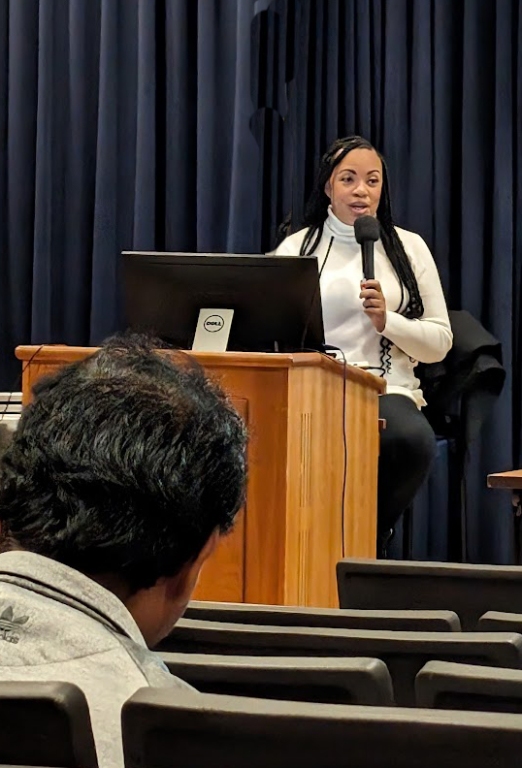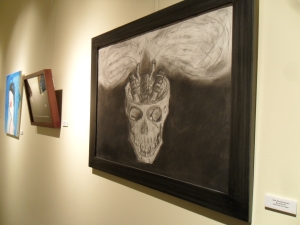By Heather Cass, Publications Manager, Penn State Behrend

Young Adult author Tiffany D. Jackson, above, visited Behrend to discuss her craft and the challenges of publishing in a tumultuous time.
In the 1970s and 80s, kids didn’t have tablets or computers, but nearly everybody had a Magic Slate, which was a cardboard drawing toy with a black waxed background, a drawing stylus, and a plastic film overlay that you lifted to “wipe” the waxed surface—the slate—clean.
It was in playing with a Magic Slate that four-year-old Tiffany D. Jackson, today a New York Times-bestselling and award-winning author of Young Adult (YA) novels, discovered the magic of writing.
“I realized that if I put letters together, I could make words, and I knew that words put together made a story,” Jackson said in a recent appearance at Penn State Behrend, where she shared her writing journey in a public presentation and in small-group sessions, including a Q&A with eighth-grade students from the City of Erie’s Eagle’s Nest Leadership Academy.
As a young black girl attending a predominately white high school in Montrose, New York, Jackson said that writing was a form of escapism for her. When she felt alone, she would dive into another world, spinning stories involving characters who looked like her, her friends, and her family.
She was fifteen when she completed her first book, written entirely in earth science class.
“I hated that class, and I spent all my time in it writing, just channeling my teenage angst into a book,” she said. “I got a ‘D’ in the class, which is something my mother enjoys telling people when she brings that handwritten book out.”
As a young reader, Jackson loved thrillers, especially horror. “I went right from R.L. Stine (author of the popular Goosebumps books for kids) to Stephen King,” she said.
As a writer, she specializes in the same genre that captivated her. Jackson’s novels–which include Monday’s Not Coming, Allegedly, Let Me Hear a Rhyme, Grown, White Smoke, Santa in the City, The Weight of Blood, and Blackout (co-author)–combine the realism of social issues with elements of thriller, horror, and supernatural genres.
She draws ideas from real-life news stories, imagining them in a different setting, with a unique cast of characters, or from a distinctive perspective. Her second book, Monday’s Not Coming, was inspired by a news story about a mother who had killed and buried her five children. Jackson found herself wondering about the best friend of the oldest child, a teen.
“What would it be like to be the best friend of a missing/murdered girl? Suddenly, your best friend is just gone,” she said.
Jackson’s latest published novel, The Weight of Blood, is a retelling of King’s Carrie set at a school’s first integrated prom. The storyline was inspired by a Georgia high school that held its first integrated prom in 2014.
Racism, inequality, and social issues figure heavily into Jackson’s novels because they figure heavily into teenagers’ lives.
“People grossly underestimate what kids can understand and handle,” she said.
Enter nervous adults who feel the need to shelter them.
“Almost my entire catalog is banned in some states,” Jackson said. “It hurts me to think that my words are so heinous that they’d want to hide them from young people who need them most. In most cases, the book banners are literally opposing facts.”
What book banners describe as “protecting kids,” Jackson asserts, is setting kids up to fail.
“Reading stories, putting yourself in another person’s mind and world, creates empathy. Empathy leads to compassion, which leads to action, which leads to change,” she said. “Don’t we want our kids to know and do better?”
Jackson encourages teens to challenge book ban efforts.
“I tell kids to make adults sweat,” she said. “Go to school board meetings, go to library council meetings, and speak up. Hold adults accountable for the decisions they are making that are detrimental to your future.”
In Brief
Education: A bachelor’s degree in film and television from Howard University and a master’s degree in media studies from The New School.
Career: Jackson worked for a decade in the television industry for National Geographic, BET, and BBC America before becoming a full-time writer seven years ago.
First book: Allegedly, which Jackson wrote when she was 30. HarperCollins published it five years later.
Challenges, big and small: Jackson said she faced scrutiny as a black woman writing horror, and the “soft” racism of publishers who told her, “Black kids don’t read.” Of those experiences, she said, “I had to do a lot of proving people wrong. Fortunately, that is one of my favorite activities.”
What you’d be surprised to know about her: To this day, Jackson has taken only one creative writing course. She learned to write by reading. “Writers are readers,” she said.
Not just for teens: Jackson’s books have a huge adult following. “I think sometimes that my books answer questions they had when they were young,” she said. “They can finally get some answers for their inner child.”
She’s a plotter: Jackson plans her book plots in advance and has an outline.
But she doesn’t always start at the beginning: “I usually start with whatever scene pops into my head,” she said. “Then the novel blooms out from that scene.”
She’s not messing around on her smartphone: Jackson does a lot of writing on her phone. “My notes app is crazy,” she said. “People will see me engrossed in my phone and think I’m looking at social media, but I’m writing scenes, chapters, dialogue. When I was working in television, I would write on sets, in between meetings, whenever I had a few minutes.”
Her cure for writer’s block: “Put yourself in your character’s shoes,” she said. “Watch something they would watch or listen to music they would like or go do something they would do.”
Advice for young writers: “Start now. Write now. Tell your stories and publish them on Wattpad or any other self-publishing format,” she said.
Advice for writers who feel invisible: “Write a book so good that they can’t ignore you,” Jackson said.
Website: writeinbk.com
While at Penn State Behrend, author Tiffany D. Jackson, far left, met with several groups, including holding a Question-and-Answer session with eighth-grade students from the City of Erie’s Eagle’s Nest Leadership Academy. The students all went home with some of Jackson’s books, courtesy of Books for Kids and Behrend’s Women’s Engagement Council.

















